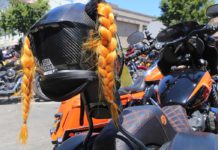With the boating season ramping up, Lake Sonoma and Lake
Mendocino are being closely monitored for invasive species of
mussels infesting lakes and rivers in Southern California and
Nevada.
With the boating season ramping up, Lake Sonoma and Lake Mendocino are being closely monitored for invasive species of mussels infesting lakes and rivers in Southern California and Nevada.
Neither lake is yet subject to the tough measures imposed by Lake County officials in their effort to protect Clear Lake. Boaters there are required to have inspection stickers and violators are subject to fines of up to $1,000 and six months in jail.
The Zebra and Quagga mussels so far have not been found in the two reservoirs or Clear Lake. For Lake Sonoma and Lake Mendocino, boat owners and fishermen are being advised to clean their boats, bilges, wet tanks and fishing tackle before coming to the lake.
“We have hosts at kiosks giving out the cards talking about the mussels, they are the best contacts,” said Joe Lishka, an Army Corps of Engineers ranger at Lake Sonoma. “Our concern is that people are traveling from one lake to another; that is the possible vector for bringing the mussel here.”
Boats and fishing tackle are considered the likely ways the small European mussels, first found in the Great Lakes in the 1980s, are being spread throughout the United States.
“In California, most are still in the southern part of state, the lakes fed along the Colorado River aqueduct,” said Ronald Smith, invasive species program coordinator for the U.S. Fish and Wildlife Service. “Most are in San Diego County. The closest is the Zebra mussel infestation at San Justo Reservoir in San Benito County. That is now closed; people cannot use it any longer.”
The mussels are the size of pin heads as juveniles and can be hard to detect, but can grow to be an inch and a half as adults. They cling to boat hulls and docks, clog pipes and can even cause boat engines to overheat and fail.
At Lake Sonoma, the mussels probably would not damage the Warm Springs Dam intakes and pipes, but anything downstream in Dry Creek and the Russian River could be impacted.
“It could affect the water supply and could potentially impact the coho broodstock program that is right below the dam at the hatchery,” said Brad Sherwood, a spokesman for the Sonoma County Water Agency, which shares operation of the dam with the Army Corps of Engineers.
The mussels are filter feeders that can deplete the oxygen in the water, Smith said.
“In high densities they filter all the plankton and algae out of the water and strip it clean, so nothing is left for juvenile fish that need that to survive,” Smith said. “It can cause the collapse of fisheries. They alter the ecosystem. They are pretty nasty little guys.”
In some areas, boats are required to be power washed and inspected before being allowed onto a lake, an expensive process that so far is not being employed at Lake Sonoma and Lake Mendocino.
At Lake Sonoma, signs have been erected at the public boat ramp and information is being distributed at the private marina.










